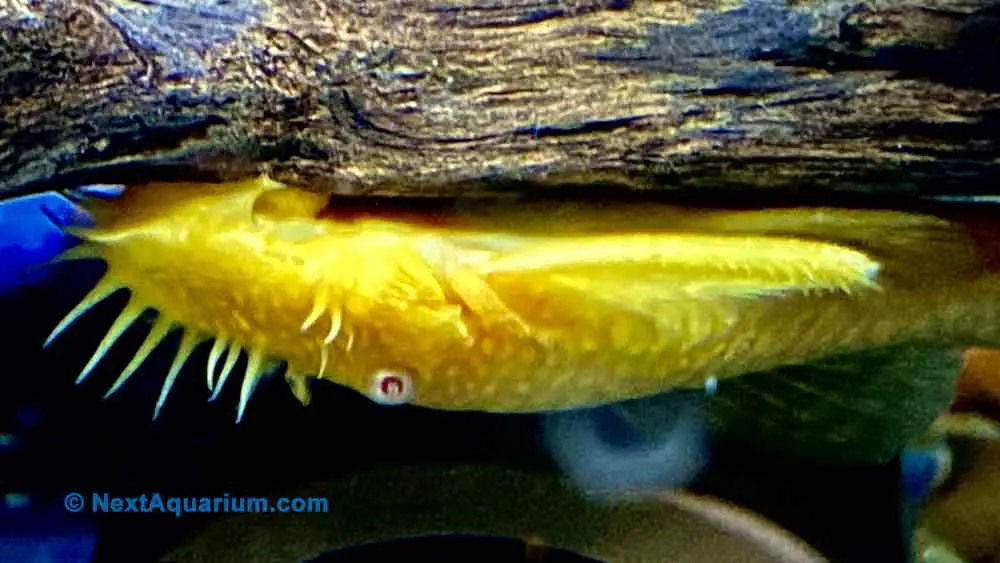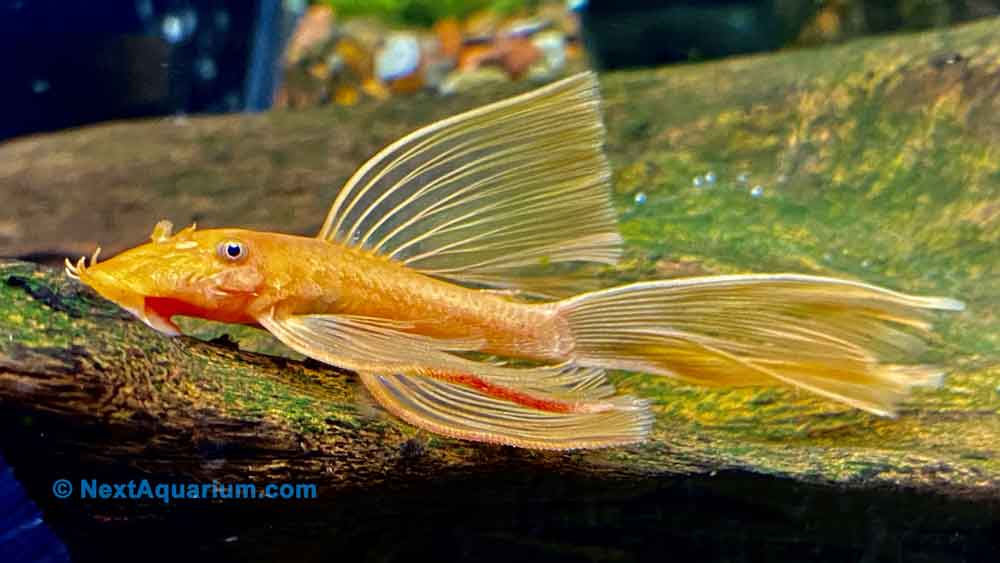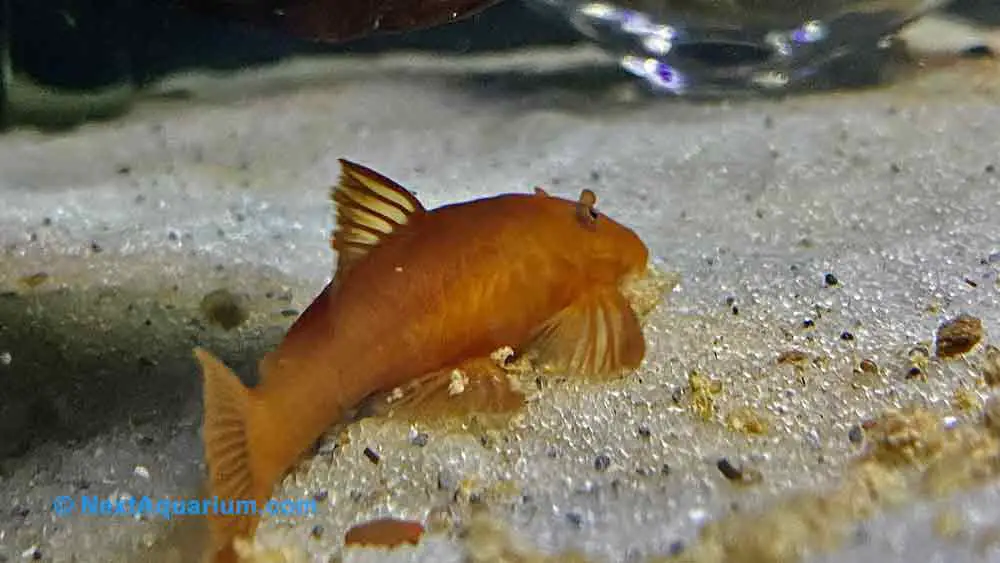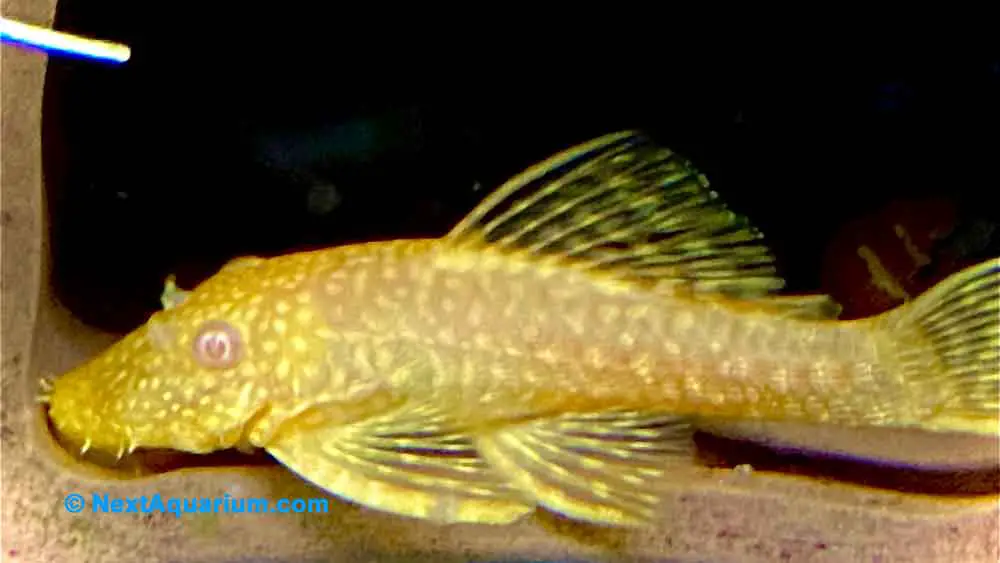Bristlenose Pleco (a.k.a Bushy Nose Pleco or BushyNose Pleco) is a beautiful algae eating fish that stands out for its unique look and behaviour. If you are setting up a new tank or having a community tank, Bristlenose Pleco fish should probably be on your list. As they provide both beauty and functionality to your aquarium. Brislenose pleco or Bushynose Pleco is one of the most kept Pleco in the aquarium hobby. Most people keep them in their aquarium to clean the tank off algae and excessive food.
Before you buy your next BN Pleco it’s best to read this article and see if it’s the right fish for you or not. In this Bristlenose Pleco Care Guide, we tried to answer all your questions and provide all the information you need before deciding to bring home one.
- Bristlenose Plecos Profile & Overview
- Origin and Distribution
- Bristlenose Pleco Size & Growth
- Bristlenose Pleco Lifespan
- Appearance & Types of Bristlenose
- Behavior & Aggression
- Bristlenose Pleco Care
- Bristlenose Pleco Tank Size
- Tank Setup
- Common Diseases and Prevention
- Diet and Feeding Requirements
- Sexing Bristlenose Pleco
- Bristlenose Pleco Breeding
- Bristlenose Pleco Tank Mates
- Conclusion
Bristlenose Plecos Profile & Overview
| Family | Loricariidae |
| Origin | Amazon River |
| Behaviour | Peaceful – Community fish |
| Diet | Herbivore |
| Breeding: | Egg layer – Cave breeder |
| Care Difficulty: | Easy |
| Preferred pH: | 6.5 – 7.5 |
| Preferred Temperature: | 78 – 82 F |
| Tank Level: | Bottom |
| Min. Tank Size: | 20 and up |
Bristlenose Pleco is a small, peaceful, friendly, adaptable and hardy fish. Like all plecos Bristlenose Pleco is also a spice that originates from Amazon River; however, Bristlenose Pleco is result of multiple line breeding and in some cases cross breeding it with other types of plecos. This makes it super hard to identify the original wild specimen that the captive bred BN Pleco came from. This is a very hardy fish that can live in most water conditions in an aquarium and are an ideal fish for any community tank. Bristle Nose Pleco is one of the best tank cleaners as they perform the daily task of removing the algae from the glass and decoration.
They come in brown, green, red, albino, calico, and snow-white coloration and with white spots in some cases. Some species might have irregular coloration: they have lighter and darker spots of varying sizes on different parts of their body. They mostly come with a dark colored hard back but a lighter soft belly. However, there are some exceptions, for example, the albino bristlenose plecos have a uniform albino color all over their body

This species has a unique appearance that will add some variety to you your aquarium. Throughout maturity, the males will start to grow bristles on their heads, which they are named after it.
Origin and Distribution
As mentioned above, the original Bristlenose Pleco originates from the Amazon river in South America but as a result of many years of line breeding it lost its original characteristics and currently its head to match it with a wild type. The Scientific name for Bristlenose Pleco is Ancistrus Cirrhosus and it believe to be originated from Paraná River basin in South America.
Currently Bristlenose Pleco is available almost any pet store around the world.
Bristlenose Pleco Size & Growth
The Bristlenose Pleco is a popular and easy to care small sucker mouth catfish that grows quickly, but will not outgrow your aquarium. One of the most common questions asked by new aquarium owners is:
How big do Bristlenose Plecos get? The answer to this question largely depends on the genes of the fish and how they are cared for until they reached maturity. Bristlenose Plecos usually grow to 3.5 to 4.5 inches in length and males specimen might grow up to 5 inches in some rare cases.
Like all fish, they grow faster and bigger in a bigger aquarium and might stay small in a smaller aquarium. The size of the tank you purchase will have a large impact on the size and health of your Bristlenose Pleco. A tank that is too small can lead to stunted growth and health problems
As mentioned above the Bristlenose Pleco can grow up to 5 inches once placed in an adequate-sized tank and a good care. The approximate time for the fish to grow to breeding size is about 1 to 1.5 years, during this time the fish will grow to 2.5 – 3.5 inches but the rate of growth becomes very slow after that.
Bristlenose Pleco Lifespan
Under optimal care with the right nutrition, Bristlenose Plecos can live up to 12 years!
These fish can adapt to much diverse range of water parameters so the water parameters seem to not effect their life span as long as its clean and the right temperature. That being said, like most Amazon River fish they prefer softer water with lower TDS.
Appearance & Types of Bristlenose
Bristlenose Pleco shares most of the characteristics Loricariidae family, but the unique feature of this fish is that it develops bristles on its heads and around the lips. Bristlenose Plecos have a boney back to protect themselves from predators. The mouth is located under the armoured head which helps the fish to not expose its super soft belly to the predator fish while swimming around on the surfaces for food.
Bristlenose Plecos usually start developing bristles at 6-8 months old. The males have more pronounced bristles, and they generally grow taller on the head. On females however, the bristles grow around their mouths and are shorter, but most females won’t grow bristles at all.
Bristlenose might look very similar to other Loricariidae cat fish but they look completely different than any other fish in the aquarium hobby.
The patterns on common Bristlenose Pleco helps camouflages perfectly both in nature and in aquarium but the line bred ones lack that which Maes them easy to see in the tank. Dark colors such as brown and green blend in with the soil and plants of the Amazon basin as well as in most aquariums.
Bristlenose Plecos are line bred to a few different color variations, with the most common being Albino and Super Red. Regardless of the color they have on their back, their bellies are almost always slightly lighter but the same colour as they have on their back. BN plecos have one pair of pectoral fins, one pair of abdominal fins, and a pair of dorsal fins along their body.
Longfin Bristlenose Pleco
As the name says, LongFin Bristlenose Pleco has been bred to have beautiful long fins. Long Fin BN Pleco is probably the most sought after type of BN pleco as it gives a different look to the tank while having all the perks the common Bristlenose Pleco comes with. Currently, all color variants of the Bristlenose Pleco also come in long fin form too.

Super Red Bristlenose Pleco
The Super Red Bristlenose Pleco is aptly named because its body is predominantly orange and red all over. This makes the fish to stand out significantly in the tank, specially in a black background aquarium.

Albino Bristlenose Pleco
After the super red type, Albino Bristlenose Pleco is the most purchased Pleco in any pet store. Unlike super reds that are not available all the time, it seem like pet stores has a steady supply of the Albino BN Plecos. This might be due to its vast availability and its ease of breeding. More on breeding in the breeding section of this guide.

Calico Bristlenose Pleco
Calico Bristlenose Pleco is result of breeding super reds with other coloration of BN pleco which slowly opens its way into the heart of aquarium owners. Currently Calico BN Pleco is one of the trendy types of plecos and more breeders are trying to bring out more unique patterns.
Snow white Bristlenose Pleco
Snow White Bristlenose Pleco is the newest color-variation of Bristlenose that was first developed in Europe. As the name mentions, its a very white color Bristlenose Pleco with spots of pink on the head areas. the pink becomes more visible if the fish is under stress or water parameters are not ideal. Snow White Pleco is a very fragile fish as it has not yet developed a strong genetic composition to be able to handle wide range of water parameters in different aquariums. It comes in Long fin and short fin variations.
Green Dragon Bristlenose Pleco
The Green Dragon Bristlenose Pleco is a another rare type of BN Pleco that is believed to be cross bred with other L number Plecos to create its unique green coloration. Unlike the common BN Pleco, Green dragons come with more uniform green colors and no white spots on their body.
L144 Blue Eye Bristlenose Pleco
The L144 Blue Eye Bristlenose Pleco is another famous type of BN Pleco in the aquarium hobby. L144 is often mistaken with Albino Bristlenose Pleco but if you look closely it’s obvious they are different fish. L144 has blue eyes and has more orange color with less white spots on the body compared to the red Eye Albino Bristlenose Pleco
Behavior & Aggression
Bristlenose plecos are known for their calm and peaceful nature. They’re not aggressive with other inhabitants in the tank, so they make a great addition to a community aquarium. Be sure the fish has enough food to eat if you are housing them with other bottom feeders. Bristlenose Plecos can live happily with all small fish and shrimps without causing any harm to them. If you’re keeping more than one Pleco in your aquarium you’ll need to make sure they have enough hiding spots as the males tend to be more territorial and fight with each other over hiding spots and or caves.
Bristlenose Pleco Care
This easy to care fish prefers to live in well-aerated water with enough water flow. the best way to care for Bristlenose Pleco is to try to make your aquarium as close to nature as possible. To make this happen, you should put lots of rocks and driftwood in the aquarium as well as lots of plants in the fish tank. Placing a few caves can also be beneficial if you have more than one Pleco and you don’t mind them breeding.
This will give them a darker place to hide during day where they are mostly inactive. Despite being herbivores in nature, fish will not cause any harm to live plants.If you see they are mulching on your plant, they are either eating algae off the plant, the leaf is dying or you are not providing them enough food.
Bristlenose Plecos are heavy eaters, meaning they will eat non-stop and which cause higher bio load in the tank. Ammonia can be very harmful to all fish in an aquarium, regular maintenance and feeding less will solve this problem. Plecos appreciate well oxygenated water and higher temperatures, try to add air stones to the tank and rain the heat to 78 – 80 F.
Bristlenose Pleco Tank Size
Depending on how heavy your aquarium is stocked, Bristlenose Plecos can thrive in tanks with 25 gallons or more. We have seen people keeping a single Bristlenose Pleco in a tank as small as 10 gallons which we do not recumbent at all. The fish might stay alive in a small tank but it defiantly won’t thrive.
BN Plecos are one of the most popular fish in the hobby, known for their “cute” appearance and more importantly, their tendency to stay small. These little guys (5-inch max) do not require a lot of attention and care, but it’s important to place them in a larger tank.
As mentioned, they need at least a 20-25 gallon tank, please keep in mind this is only for a single Pleco and if you want to keep more of them you will need a bigger tank. A bigger tank gives them plenty of room to swim around the bottom and sides of the tank. They will explore the sides and aquarium glass as well. This means they will not swim in the water column and leave that area for any other fish that may be in the tank with them.
Tank Setup
Now that we know what size of tank is needed for them, lets talk about the perfect tank setup for them. You’ll find your BN Pleco fish thrive when you mimic its natural environment with a lot of rocks and different types of driftwoods. Plecos are nocturnal fish meaning and mostly active during night when other fish are resting. This means during the day they will need somewhere to hide from other predator fish both in the tank and in the aquarium.
Plecos also produce a lot of waste, consider choosing a good filter that has enough capacity to handle the waste they make. For a community tanks, we always recommend buying a filter that is at least rated twice the capacity of your tank. Some might say its an overkill but from experience buying stronger filters will save you time and money in the long run. look for the bigger tanks that have enough room for individual fish in case some of the fish get territorial and need their own space. Large aquarium and filters also provides ample space for the bacteria to grow and the risk of excess production of waste is eliminated.
Decorations:
Bristlenose is an active fish when given enough hiding spaces in the aquarium. You will find Plecos super active in darker spaces, behind aquarium plants, driftwoods, and caves. Live plants, decorative items such as castles, and caves are perfect for keeping these fish amused and reduce their stress. Driftwood is a must have item in the tank and try to add different types. Driftwood is a part of Bristlenose Pleco which we will talk more about it in the diet section.
Live aquarium plants are another important item to add, tho not necessary. Live plants provides a natural, healthier, and safer environment for the fish. We recommend avoiding artificial plastic plants as they are not providing any benefit to the aquarium and sometimes their sharp edges can harm fish. If you can’t have natural plants for any reason artificial plants can be a good alternative.
Lighting:
Bristlenose Plecos do not have specific lighting needs and can adapt to any lighting conditions in the aquarium. So it’s best to choose the light based on the plants you are keeping in the tank. In general, Plecos do better in darker places which means you should avoid strong lighting if you don’t have plants. When if you have plants then try to add more decorations and hiding spots for them to hide during the time aquarium lights are on.
The LED light is the recommended lighting for your plants because they are cost-effective for the long term, giving your aquarium water garden the necessary natural light. Most LED lights come with an automatic timer and can be programmed to turn on and off at specific hours.
Filteration System:
Bristlenose fish eats a lot, which leads to high levels of waste frequently. If the filtration of the aquarium can not keep up with the waste production, it will affect the health of fish leading to infection or disease, or even death. To solve this problem, we need to have good filtration system that can filter the tank mechanically and biologically.
A hang-on back filter or canister filter is the best option for filtering the water. when purchasing a filter always go for a two times the recommendation on the package, the bigger the filter the better environment for the fish. bigger filters will also provide more water movement with plecos love. Speaking of water flow, You can also look for a few air stones and a powerhead to improve the water flow in your tank while aerating your aquarium. Plecos love well-aerated water and the dissolved oxygen in the water will ensure a healthy level of bacteria in the tank to take care of any waste products in your aquarium.
Common Diseases and Prevention
Bristlenose pleco does not get sick very often. Generally, they’re healthy and do well in any tank as long as you feed them properly and maintain the water quality. However, they are susceptible to all common aquarium diseases so we highly recommend reading our articles about each diseases before you face it in your tank. prevention is better than curing!
Remind yourself to clean the tank and its decorations regularly, take care of all the water parameters, and ensure there are enough hiding places for fish to be healthy during the whole lifespan.
Diet and Feeding Requirements
Bristlenose Plecos are mainly eating algae, wood, freshwater sponges, and sometimes small larva in nature. There are many commercially made food specially for plecos which provide all the necessary components Bristlenose Pleco need. However, most available food do not have wood which means you will have to add driftwood directly to the tank so the fish can have a balanced diet. Algae wafers or spirulina wafers are a staple food for bristle-nose Plecos. Try to add fresh vegetables like zucchini, carrots, green pea, cucumber to your aquarium as they love to eat fresh vegetables.
Feeding your fish with a balanced diet of pellets, flakes, fresh vegetable, and sometimes meaty foods like bloodworms can be an excellent way to keep them healthy.
Sexing Bristlenose Pleco
Sexing adult Bristlenose Plecos are very easy. Males can be told apart from females by the bristles on their heads. As mentioned in the appearance section of this article, the males will grow bristles and females will not. The bristles are the most obvious gender difference in Bristle-Nose Plecos. However in some cases females will also develop bristles but female bristles are very short and are only around its lips and not on the head. During breeding season males might also grow spikes on their dorsal fins.
Bristlenose Pleco Breeding
The breeding of Bristlenose fish is very easy and can be done with out any special effort. To increase the rates of breeding, we recommend keeping a 1:2 ratio of males to females in your tank. Doing so will also decrease the level of aggressive behavior. If you have a more males in your tank, then make sure that there are plenty of hiding spots for the fish so they can have their own peaceable haven. The rule of thumb is to add one cave per male.
Bristlenose places are cave breeders which means you need to add caves for them to breed. The cave should be slightly bigger than the males body but small enough that he can trap the female inside. For breeding purposes, the male looks around for a suitable place to trap the female. This could include caves, under rocks, or any place where the male can trap the female and force her to lay eggs.
When the male finds a suitable cave, he will clear it out and waits for the female to arrive. The male will then trap the female and will not let her leave the cave until she lays eggs. Once she lays her eggs the male will let the female leave the cave and then fertilize the eggs.
It’s the male job to guard the eggs until they hatch. During this time, the male cleans the eggs and fans them so the eggs don’t go bad or get mold. The eggs usually hatch 4-5 days after being laid.
After hatching, fry are usually staying at the back of the cave and attach to the sides and feed on their egg sacks for the next few days. The male will keep the fry in the cave for another 5-7 days until they are fully developed.
After approximately 5-7 days fry are strong enough to scape the cave and will attach to driftwood or glass in the aquarium. They usually stay together in a cluster in a single spot until they grow to an inch in length. At this age, they do not have their bristles which makes it impossible to determine their sex.
It’s no secret that these fish look stunning. Plus, they’re bred and distributed all over the world, which makes them accessible to everyone everywhere!
Bristlenose Pleco Tank Mates
BN Plecos can live with any peaceful to medium aggressive fish, they can also live with snails and shrimps or other algae-eating fish. If you have a community tank then Bristlenose Pleco is a must-have. However, we do not recommend keeping Bristlenose Plecos with super aggressive fish as they might eat your Pleco or stress it out to death. In a big aquarium, BN Plecos can even live with any cichlid with a small mouth such as angelfish or discus.
Conclusion
By now we know keeping Bristlenose Plecos are very easy and they are not a sensitive super demanding fish. All you need to focus on is to provide them with clean water and proper diet and they will keep you entertained for years to come.
Congratulations, now you know all there is to know about caring for the Bristlenose Pleco! So what type of BN Pleco do you want to bring home?
if you have any questions or need more help please reach out to us on social media or via our contact us page. We would love to help.